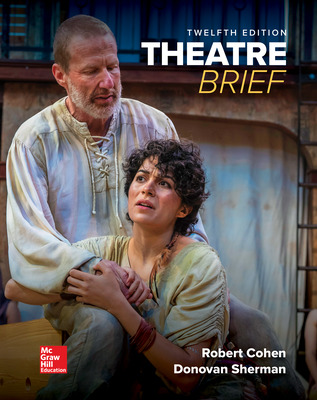Description
Test Bank For Theatre Brief 12Th Edition By By Robert Cohen
Introduction
Chapter 1 What Is Theatre?
Chapter 2 What Is a Play?
Chapter 3 The Actor
Chapter 4 The Playwright
Chapter 5 Designers and Technicians
Chapter 6 The Director
Chapter 7 Theatre Traditions
Chapter 8 The Modern Theatre
Chapter 9 Musical Theatre
Chapter 10 Theatre Today
Chapter 11 The Audience
The Ancients
The Middle Ages
The Renaissance
The Theatre of Asia
The Royal Era
The Modern Theatre: Realism
The Modern Theatre: Antirealism
Theatre, Brief, 12e (Cohen)
Chapter 2 What Is a Play?
1) What is a play?
A) a story in dialogue form written in a book
B) a single oral performance of a story
C) an action framed and focused around a particular conflict, which gives the action significance
D) performance on a stage using live actors and musical accompaniment
Answer: C
Learning Objective: Recall the beneficial effects of plays.
Bloom’s: Remember
Accessibility: Keyboard Navigation
2) The word “drama” comes from the Greek dran, which means
A) to make.
B) to play.
C) to do.
D) to dance.
Answer: C
Learning Objective: Recall the beneficial effects of plays.
Bloom’s: Remember
Accessibility: Keyboard Navigation
3) In Greek tragedy, central characters
A) undergo a change that leads to their demise due to a tragic flaw in their character.
B) never interact with the lesser characters.
C) always descend from the gods.
D) always have the option of avoiding conflicts.
Answer: A
Learning Objective: Identify the main characteristics of tragedy.
Bloom’s: Remember
Accessibility: Keyboard Navigation
4) The purging or cleansing of the audience’s pity and terror at the climax of a tragedy is called
A) hamartia.
B) exposition
C) containment
D) catharsis.
Answer: D
Learning Objective: Identify the main characteristics of tragedy.
Bloom’s: Remember
Accessibility: Keyboard Navigation
5) Which of the following is true about the differences between tragedy and comedy?
A) Tragedy typically deals with great people, whereas comedy deals with ordinary people.
B) Tragedy leads to the audience feeling disgusted about going to the theatre at all.
C) Tragedy is always about the Gods, whereas comedies are only about mortals.
D) Tragedy is about soap-opera types of conflict, whereas comedy is usually about a new major social and political awareness.
Answer: A
Learning Objective: Identify the main characteristics of tragedy.
Bloom’s: Remember
Accessibility: Keyboard Navigation
6) Which of the following is true of tragic heroes? (Select all that apply.)
A) Tragic heroes have superhuman powers.
B) Tragic heroes face huge odds.
C) Tragic heroes are always flawed in some way.
D) Tragic heroes are victims of their circumstances.
Answer: B, C
Learning Objective: Identify the main characteristics of tragedy.
Bloom’s: Remember
Accessibility: Keyboard Navigation
7) Why do comedies typically go out-of-date more quickly than tragedies?
A) Comedies were historically written on parchment, whereas tragedies were inscribed on stone.
B) Comedies used the common slang of the time, whereas tragedies are written in more refined language.
C) Comedies are more topical and deal with ordinary life at the time they are written.
D) Comedies utilize more stagecraft and precise timing than tragedies.
Answer: C
Learning Objective: Identify the main characteristics of comedy.
Bloom’s: Remember
Accessibility: Keyboard Navigation
8) The play Notes from the Field can be classified as
A) a documentary drama.
B) a melodrama.
C) a history play.
D) a musical.
Answer: A
Learning Objective: Recognize why plays can fit into multiple genres.
Bloom’s: Understand
Accessibility: Keyboard Navigation
9) Arthur Miller’s Death of a Salesman is different than its classically tragic ancestors because
A) it contains scenes of absurd humor.
B) it does not contain Gods, but rather contemporary forces.
C) Willy Loman was a rich bureaucrat.
D) it has more than one major tragic character.
Answer: B
Learning Objective: Identify the main characteristics of tragedy.
Bloom’s: Remember
Accessibility: Keyboard Navigation
10) The Greek term for the “carrier of the action” in a tragedy is
A) antagonist.
B) protagonist.
C) catharsis.
D) hamartia.
Answer: B
Learning Objective: Identify the main characteristics of tragedy.
Bloom’s: Remember
Accessibility: Keyboard Navigation
11) A play that dramatizes the key events in the life of a historical figure, such as George Bernard Shaw’s Saint Joan, is called
A) a history play.
B) tragicomedy.
C) a farce.
D) a burlesque.
Answer: A
Learning Objective: Recognize why plays can fit into multiple genres.
Bloom’s: Understand
Accessibility: Keyboard Navigation
12) Ultimately, the practice of dividing plays into genre is
A) not helpful to an audience member in deciding which play to go see.
B) of no interest to the production team of actors, designers, and producers.
C) always subjective because each play is unique.
D) observed only for high scholarly writings to be analyzed.
Answer: C
Learning Objective: Recognize why plays can fit into multiple genres.
Bloom’s: Understand
Accessibility: Keyboard Navigation
13) Which dramatic genre purports to be serious but, in fact, deals with human issues on only the most superficial level, embellished with spectacular staging, flamboyant dialogue, and highly suspenseful and contrived plotting?
A) documentary drama
B) tragicomedy
C) melodrama
D) farce
Answer: C
Learning Objective: Recognize why plays can fit into multiple genres.
Bloom’s: Understand
Accessibility: Keyboard Navigation
14) Which dramatic genre offers a wild, hilarious treatment of a trivial theme, usually based on a stock component like identical twins, switched identities, lovers in closets, and might include full-stage chases, misheard instructions, various disrobings, discoveries, and disappearances?
A) dark comedy
B) melodrama
C) farce
D) tragicomedy
Answer: C
Learning Objective: Identify the main characteristics of comedies.
Bloom’s: Remember
Accessibility: Keyboard Navigation
15) A play’s components and its timeline are both elements of the play’s
A) dramaturgy.
B) plot.
C) conventions.
D) action.
Answer: A
Learning Objective: Recall the two components of dramaturgy.
Bloom’s: Remember
Accessibility: Keyboard Navigation




Be the first to review “Test Bank For Theatre Brief 12Th Edition By By Robert Cohen”